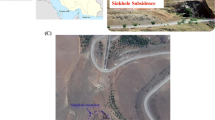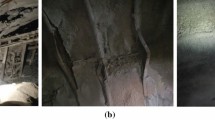Abstract
The influence of dip directions on the main deformation region of layered rock around tunnel is studied using a 3D distinct element code called 3DEC. We learn that the main deformation regions around tunnels are regularly changeful along with different intersection angles between dip direction and advancing direction of the tunnel. The specific deformation regions can be anticipated based on detailed engineering geological survey before tunnel excavation. Moreover, the common deformation pattern around tunnels is found to be structural deformation including bending and slipping of layered rock. The main deformation region is prone to occur at the region where the normal direction of rock layer points to the inside of tunnel because the minimum tensile strength of bedding plane appears on this region and rock bending is generally easier than rock slipping. An understanding of the main deformation regions around tunnels provides critical information for selecting the route of a tunnel, forecasting the main deformation region and designing an efficient support system.







Similar content being viewed by others
References
Bakun-Mazor D, Hatzor YH, Dershowitz WS (2009) Modeling mechanical layering effects on stability of underground openings in jointed sedimentary rocks. Int J Rock Mech Min Sci 46:262–271
Cundall PA (1980) A generalised distinct element program for modelling jointed rock. Report PCAR-1-80, Contract DAJA37-79-C-0548European Research Office, U.S. Army, Peter Cundall Associates
He MC (2011) Physical modeling of an underground roadway excavation in geologically 45° inclined rock using infrared thermography. Eng Geol 121:165–176
ITASCA Consulting Group (2007) Itasca, 3DEC, Version 4.1
Jia P, Tang CA (2008) Numerical study on failure mechanism of tunnel in jointed rock mass. Tunn Undergr Space Technol 23:500–507
Jing L (2003) A review of techniques, advances and outstanding issues in numerical modeling for rock mechanics and rock engineering. Int J Rock Mech Min Sci 40:283–353
Park SH, Adachi T (2002) Laboratory model tests and FE analyses on excavating a tunnel in the unconsolidated ground with inclined layers. Tunn Undergr Space Technol 17:181–193
Tien YM, Kuo MC, Juang CH (2006) An experimental investigation of the failure mechanism of simulated transversely isotropic rocks. Int J Rock Mech Min Sci 43:1163–1181
Wu JH, Ohnishi Y, Nishiyama S (2004) Simulation of the mechanical behavior of inclined jointed rock masses during tunnel construction using Discontinuous Deformation Analysis (DDA). Int J Rock Mech Min Sci 41:731–743
Zhang ZX, Xu Y, Kulatilake PHSW, Huang X (2012) Physical model test and numerical analysis on the behavior of stratified rock masses during underground excavation. Int J Rock Mech Min Sci 49:134–147
Acknowledgments
This work was financially supported by the program “Research for the stability of surrounding rocks and control technology in tunnels” by the Economic and Planning Research Institute of the Ministry of Railways, China (No. 2009G005-A). The authors wish to thank Professor Ming-nian Wang, Dr. Sheng-wen Qi and Dr. Xiu-hong Hu for their useful suggestions.
Author information
Authors and Affiliations
Corresponding author
Rights and permissions
About this article
Cite this article
Cui, Zd., Liu, Da. & Wu, Fq. Influence of dip directions on the main deformation region of layered rock around tunnels. Bull Eng Geol Environ 73, 441–450 (2014). https://doi.org/10.1007/s10064-013-0511-6
Received:
Accepted:
Published:
Issue Date:
DOI: https://doi.org/10.1007/s10064-013-0511-6




